The 7 Best Robot Mops of 2023, Tested and Reviewed
Dotdash Meredith and Yahoo Inc. may earn commission or revenue on some items through the links below.
Out of 24 robot mops we tested, these are the very best.
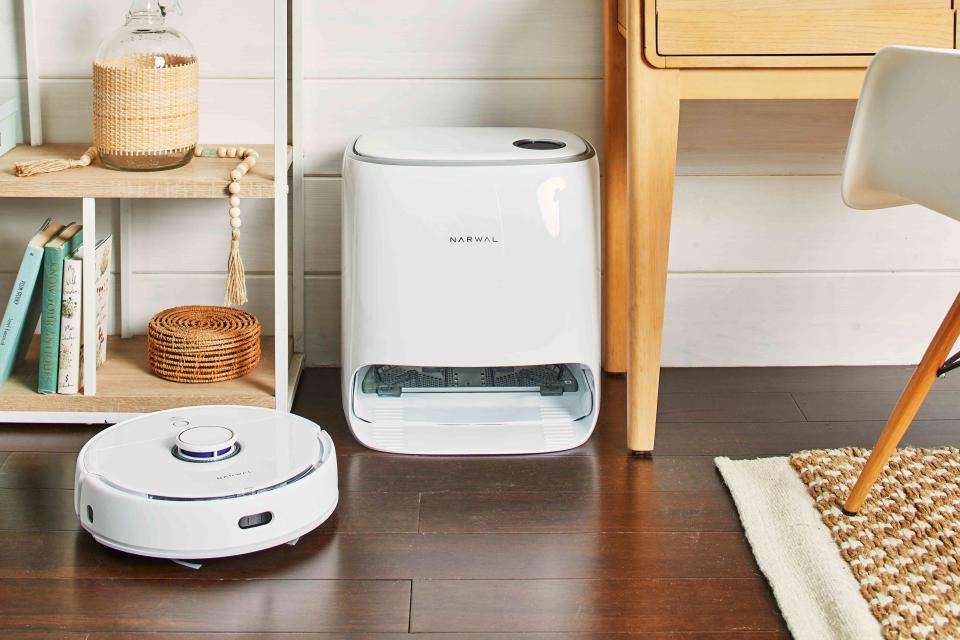
Real Simple / Dera Burreson
Fact checked by Shereen Jegtvig
Vacuuming and mopping require a lot of manual effort—unless you have a robot mop with vacuuming capabilities that can do most of the hard work for you.
A robot mop can handle everyday cleaning with a push of a button or a tap on your phone. “Simplicity and automation are the main benefits of using a robot mop over a traditional mop,” says Chris Willatt, the owner of Alpine Maids. “Turn the robot on, take a seat, and watch it clean your floor.”
Many can also adjust to different floor surfaces and go under furniture, saving you from having to crawl down on your hands and your knees or find different attachments. And for robot vacuum and mop combos, you can suck up dust and messes and wipe down your floors all with one device.
To find the best robot mops, we tested 24 different models and evaluated them on setup, effectiveness, noise level, features, maneuverability, and ease of emptying. We also talked to Toby Schulz, a co-founder of Maid2Match, and Karina Toner, Operations Manager at Spekless Cleaning, in addition to Willatt.
Best Overall Robot Mop: Roborock S8+ Robot Vacuum Mop

What Stands Out
It has quick multi-floor mapping, self-emptying capability, great object avoidance, Wi-Fi connectivity, and more.
What Could Be Improved
The self-emptying feature is loud, but can be turned off.
The Roborock S8+ has all the features you could want in a robot vacuum and mop in an easy-to-use form. In our testing, it easily picked up hair (without tangling) and everything from dust to larger debris like cereal. We found it worked particularly well on both hardwood floors and tile, and was relatively quiet when in use. The self-emptying feature is loud, but you can turn the automatic mode off and manually control when you want it to empty instead.
As a mop, it quickly made haste of some sticky residue we had on the floor with just one swipe. We didn’t notice any missed spots, and when we wiped a wet paper towel after the robot mop had done its cleaning, the paper towel stayed white, so we knew the robot map had done a thorough cleaning. The mop only uses water to clean so if you prefer using a cleaner, you will have to add one. The pad is reusable and needs to be washed after each use.
Connecting to Wi-Fi and the app was easy (there was a provided QR code), and we found the quick mapping was indeed fast—the robot map was able to quickly skim each room and create an accurate map of the house, and then it was easy to divide or merge rooms as needed. There is also a multi-floor mapping feature that allows the robot to automatically detect which floor it’s on. We found it to be extremely smart—it was able to detect someone standing in front of it and automatically slowed down, and it maneuvered well around chair and table legs and into corners. After going over a raised room divider a few times, the app asked us if there was a threshold in that spot and we were able to mark it in the app for easier cleaning. It also did well recognizing cables in a corner and marked them to avoid, preventing any accidental cord eating.
You can schedule it to run for specific rooms, and it’s easy to change the times and specify what kind of cleaning you want (vacuum and mop, vacuum only, or mop only). There are pre-set options, or you can customize your own based on your personal preferences. The spot mode feature was also easy to use; you simply pick a spot and the robot mop will go straight there. It does target a large area in spot mode, but you will get a thorough cleaning in that spot.
While it’s on the pricier side for a robot mop, this Roborock has plenty of features to make it worth the price tag.
Price at time of publish: $1,000
Dimensions: 13.9 x 3.8 inches | Dustbin Capacity: 2.5 liters | Water Tank Capacity: Not listed | Battery Life: Up to 180 minutes | Self-Emptying): Yes | Wi-Fi/Smart Home Connectivity: Yes
Best Budget Robot Mop: Yeedi Vac Station Self-Emptying Robot Vacuum & Mop
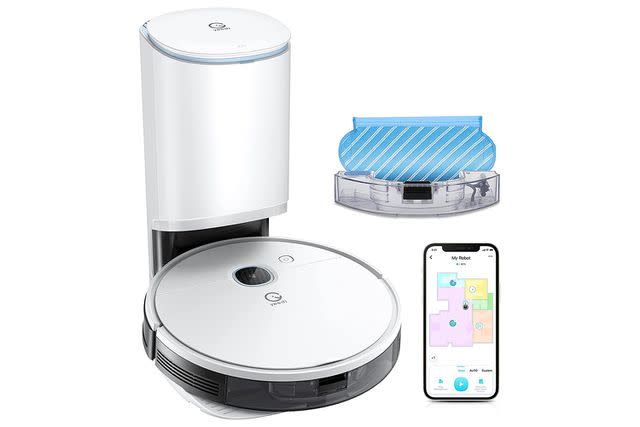
What Stands Out
Although it’s not exactly budget-friendly, it’s much more affordable than most robot mops.
What Could Be Improved
The bin can fill up quickly if you have pets that shed a lot.
If you’re looking for a good robot mop, you should expect to shell out a few hundred dollars at least. Compared to similar models, the Yeedi is less expensive, and offers more bang for your buck.
This Yeedi robot vacuum and mop is a great option that doesn’t require a ton of heavy lifting. We found that it took less than five minutes to set up, and not only will it map your house, but you can also designate no mop zones or set cleaning preferences by area. Because it can empty itself, you won't need to worry about regularly disposing of the dust or hair that it accumulates—we needed to change the bag about every three weeks at most.
When in vacuum mode, it can handle both carpet and hardwood floors, and it can go between different surfaces with ease. When in mop mode, it avoids carpet, which is a nice feature to prevent soggy carpets. After removing the mopping reservoir, the vacuum goes on the carpet to suck up any dirt and debris. It has an average noise level, but the self-emptying feature is on the louder side. And if you have pets that shed a lot, we found that the self-emptying feature was a tad less effective. One solution we found is to use the robot twice a day instead of once, so the bin is full of less hair at once.
After three months of use, we noticed that the vacuum wasn’t as quiet as it was right out of the box, although the quality remained the same. Overall after six months of use, we highly recommend this robot for its effectiveness and range of features at a relatively affordable price.
Price at time of publish: $350
Dimensions: 13.8 x 3 inches | Dustbin Capacity: 0.42-liter bin, 1.5-liter docking station | Water Tank Capacity: 0.24 liters | Battery Life: Up to 200 minutes | Self-Emptying: Yes | Wi-Fi/Smart Home Connectivity: Yes
Best Splurge Robot Mop: Narwal Freo Versatile Self Mop Clean Robot with DirtSense
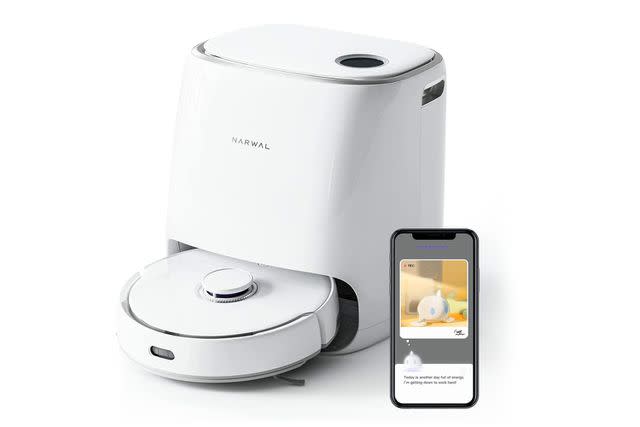
What Stands Out
With multiple cleaning modes, dirt-sensing technology, mop washing and drying and more, this robot map is packed with features.
What Could Be Improved
It doesn’t have smart home connectivity, which is a bummer considering the very high price.
Although it’s undeniably an expensive option, the Narwal Freo is an extremely effective robot vacuum and mop, especially if you have pets. We found the vacuum worked equally well on tile, wood, and carpet, and picked up everything from small dust particles and pet hair to larger objects on the floor (about half a Cheerio size).
It does a good job getting into corners and under furniture, and with object avoidance, it has no problem navigating around random things that have been left on the floor. It’s low maintenance, too—you can schedule it to run while you’re not home, and you don’t have to do much other than occasionally add water/solution and empty the dirt bin. Plus, it self-empties and self-cleans the mop.
The setup process is fairly simple, and involves installing two brushes and connecting to the Narwhal Freo app (tip: the app has to be on the entire time during the setup in order for it to work properly). Once the robot is set up, the mapping and scheduling are easy to use. You can see the progress of the mapping and cleaning in real time on your app, and we found that it only took one time for the robot to map out a floor plan. Once you have the initial map set up, you can design and name areas for cleaning, and decide if you want specific areas vacuumed and mopped, or just one or the other. The vacuum connects to Wi-Fi but is not currently smart-device compatible.
It’s also very quiet and not very intrusive, and we found that you can even watch TV at a normal level while it is both vacuuming and mopping in the room. For places that need a little extra TLC, you can use the Freo mode, which does a deeper clean. Another great feature is that it uses heat to dry, so your floors dry very quickly after mopping. In fact, we were surprised at how quickly the floors dried—the mop ran from the outside to the inside of the room, and by the time it got to the inside of the room, the outside was already dry.
Price at time of publish: $1,599
Dimensions: 13.8 x 13.8 x 4.1 inches | Dustbin Capacity: 0.48 liters | Water Tank Capacity: 4 liters | Battery Life: 210 minutes | Self-Emptying: Yes | Wi-Fi/Smart Home Connectivity: Yes, Wi-Fi
Best Self-Emptying Robot Mop: Ecovacs Deebot T10 Plus Robotic Vacuum and Mop
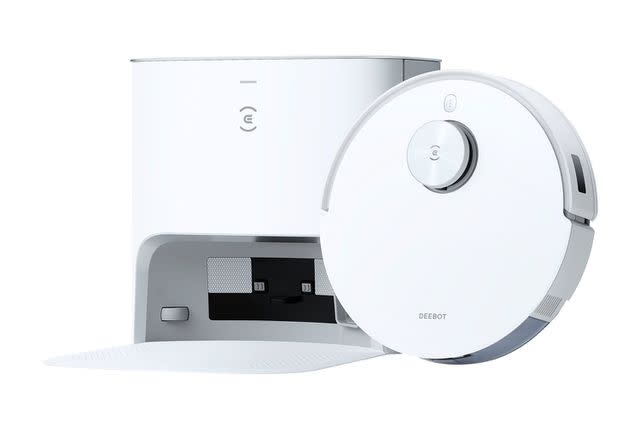
What Stands Out
A large docking station bin capacity and self-emptying feature reduces the frequency with which you need to empty the dust bag.
What Could Be Improved
It’s not as good at avoiding smaller objects and maneuvering over uneven surfaces.
One of the biggest pains of robot vacuuming is constantly having to empty the bin. The Ecovacs Deebot T10 Plus not only has a self-emptying feature, but it also has a disposable, 3.2-liter sealed dust bag that securely contains dirt and can be used for up to 60 days. It also has a self-cleaning feature for dust, so that’s one less thing you have to worry about.
The mop function has three vibration power levels and three levels of water flow, and we found it did a sufficient job of cleaning the floors, though wasn’t quite as deep of a clean as other models. Still, it’s way less work than having to manually mop the floor.
The vacuum performed well on multiple surfaces, but despite having object avoidance technology it was not as great at avoiding smaller objects on the floor. It was able to avoid a sock, but sucked up a USB cord. In addition, it had trouble going over a door threshold (about 0.75 centimeters tall) and over areas rugs that weren’t weighed down by furniture.
After taking everything out of the box and charging, it took about 6.5 hours to fully charge the robot. Setting up the app was fairly simple, although the app itself is not particularly intuitive—we spent a lot of time clicking around in the app trying to figure out where everything was.
After six months of use, we found that it actually performed better than it did originally, as it seemed to have acquired a better handle on the layout of the home.
Price at time of publish: $950
Dimensions: 13.9 x 4 inches | Dustbin Capacity: 0.4 liter bin, 3.2 liter docking station | Water Tank Capacity: 0.24 liters | Battery Life: Up to 180 minutes | Self-Emptying: Yes | Wi-Fi/Smart Home Connectivity: Yes
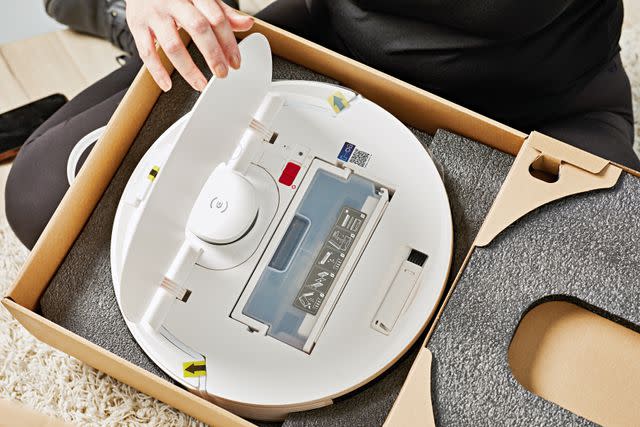
Real Simple / Henry Wortock
Best Robot Mop for Pet Hair: Ecovacs Deebot T9+ Robot Vacuum and Mop

What Stands Out
It has impressive suction and object avoidance, plus it’s very quiet.
What Could Be Improved
The self-emptying station feature won’t work if the robot mop sucks up larger objects.
If you have a lot of hair—human and/or pet—around the house, the Ecovacs Deebot T9+ cleans and self-empties after each session (although if it sucks up a larger object, like a screw, it may hinder the self-emptying feature). We tested this model on wood and tile floors and it cleaned both effectively, picking up hair, pet hair, dust, dirt, and even hair ties and bobby pins. The mop pads are disposable so you can have a fresh pad every time you clean.
The robot mop is quiet enough to be used during the day without causing much of a disruption. The TrueDetect 3D technology keeps the sound down by helping the robot mop avoid obstacles to bump into such as tables, walls, and even pets lying in its path. Instead, it detects objects and reroutes around them.
Setting up the robot mop was simple—all we had to do was slide the dust bag into the self-emptying station and fasten the side brush to the machine. Once you download the app, there’s a QR code located under the top lid to make syncing the app easier. The robot mop then does an initial smart cleaning and maps the interior of the house. In our test, it took about two hours for the robot mop to clean the upper level of the house and draw a physical diagram of the space. After the initial cleaning, you can set up cleaning schedules for every day, once a week, during the workweek, and weekends, so it can work best around your lifestyle.
Price at time of publish: $800
Dimensions: 13.9 x 3.7 inches | Dustbin Capacity: 0.4 mL | Water Tank Capacity: Not listed | Battery Life: Up to 180 minutes | Self-Emptying: Yes | Wi-Fi/Smart Home Connectivity: Yes
Best Robot Mop With Carpet Sensoring: Yeedi Mop Station Pro Robot Vacuum and Mop
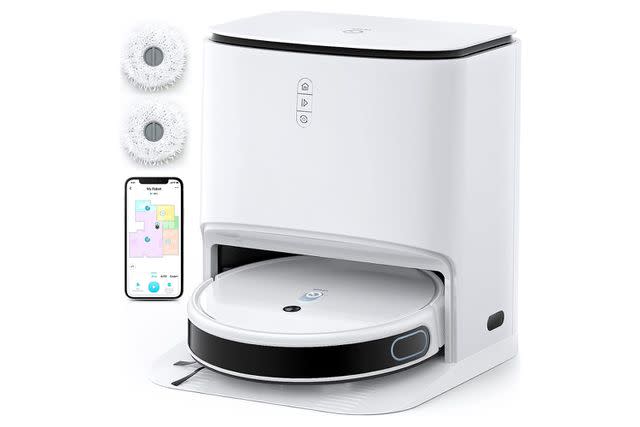
What Stands Out
It has carpet detection to keep your carpets and area rugs dry during mopping.
What Could Be Improved
There’s no self-emptying feature, and spot mode can be hit or miss.
For homes that have rugs, you want a robot vacuum and mop that can handle different surfaces so you don’t have to remove the rugs each time you’re mopping or vacuuming. The Yeedi Mop Station Pro has carpet detection that enables it to avoid carpets while mopping and increase suction while vacuuming. In our tests, this robot mop was able to detect and avoid multiple area rugs during mopping, and it cleaned the rugs just as well as it did the hard floor while on the vacuum setting. For even more convenience, the mop pads pop off after use and are made to be washed and reused; plus, the rollers detach to help you clean them if you get hair tangled inside.
This model comes pre-assembled, so all you need to do is attach the edge brush to the bottom of the robot. In fact, it took us longer to remove the packaging and read the manual than it did to set up the robot mop. After installing the app (using an included QR code) and setting up a free account, you can connect the robot mop to your Wi-Fi network.
You do need to fully charge the robot mop, which takes about two hours, before its first use. Then it’s ready to map and do an initial vacuum of your space, which takes about an hour. You can track the map in real time in the app, and after the mapping process, you can name the different rooms of the house or send it back to a specific room if you want it to do another cleaning.
The noise level of this robot increases when it’s being used at faster speeds, but overall it’s relatively quiet. It also does a good job avoiding objects such as rugs and furniture, as well as smaller objects that may be randomly laying around at any given time. The one setting it struggled on was spot mode—it did a good job cleaning but seemed to forget its mapping pattern and took a long time to return to its docking station.
While there is no self-emptying feature for the vacuum, it does empty the water into the docking station. It will, however, prompt you to clean out any dirty water, refill it with clean water, and empty the dust bin.
Price at time of publish: $800
Dimensions: 13.5 x 3.3 inches | Dustbin Capacity: 0.75 liters | Water Tank Capacity: 3.5 liters (2) | Battery Life: Up to 180 minutes | Self-Emptying: Yes, but for mopping only | Wi-Fi/Smart Home Connectivity: Yes
Best Non-Vacuum Robot Mop: Bissell ReadyClean A3 Robotic Mop
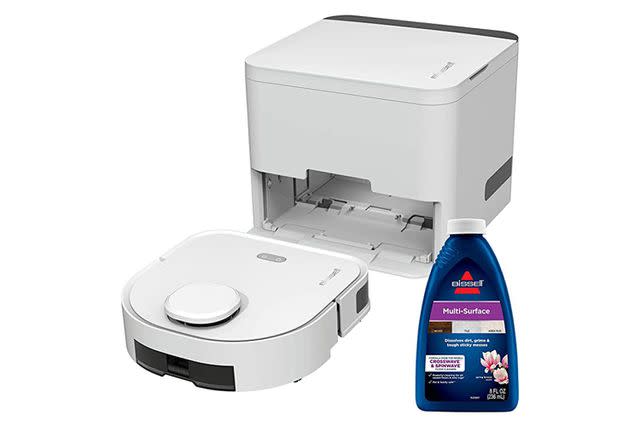
What Stands Out
It automatically swaps out cleaning pads when they get dirty.
What Could Be Improved
It has a hard time getting over small ledges between rooms.
For those who don’t need another vacuum but are looking to have cleaner floors with minimum effort, the Bissell ReadyClean A3 can help mop floors more easily and regularly. We tested it on hardwood floors, and it was extremely meticulous as it went back and forth in a horizontal line, covering every inch of the floors and leaving them looking shiny. It does well with picking up dust and debris, but anything larger will get pushed around since there is no vacuum feature.
It’s pleasantly quiet and intuitive at detecting obstacles such as rugs and cords, and will change its course after bumping into them. The D-shape design allows the mop to get to hard-to-reach spaces and it can easily navigate under furniture. The only issue we ran into was the mop's inability to get over small ledges in between rooms.
The robot mop comes with both disposable and reusable pads that are interchangeable, and can be used for either wet or dry mopping. We programmed the mop to use the reusable pads, and all four got replaced during the initial cleaning. Impressively, when the mop detected that the pad was too dirty, it would go to the docking station to automatically swap it out for a new one.
We also liked that the mop head lifts up when the robot is en route to replace its pad at the docking station, so it doesn’t drag the dirty mop across the freshly cleaned floor. The docking station can store 10 pads at a time. There were no washing instructions for the reusable pads, but we hand-washed them and determined that they can likely go through a gentle cycle in the washing machine.
Setting up the robot mop was pretty easy, although it took longer than other models. You need to fill the water tank, add the cleaning solution, attach the cleaning pads, and then charge it in the dock for about four hours. After downloading the app, you can connect to the robot via Wi-Fi, where you can schedule cleanings, select your water levels, and manage your mop and maps.
Price at time of publish: $300
Dimensions: 17.6 x 17.5 x 15.2 inches | Dustbin Capacity: N/A | Water Tank Capacity: Not listed | Battery Life: Up to 200 minutes | Self-Emptying: Automatically removes mop pads and reloads | Wi-Fi/Smart Home Connectivity: Yes
Final Verdict
Overall, we recommend the Roborock S8+, which is highly effective as both a vacuum and mop. It has all the features you would need to incorporate a robot vacuum and mop into your regular cleaning routine, such as a self-emptying function, Wi-Fi and smart device compatibility, 3D object avoidance, customizable cleaning schedules, and multi-level mapping.
Our Testing Process
To find the best robot mops, we put 24 models through a series of tests. First, we timed how long it took to get each robot assembled from the moment we opened the box, and how easy it was to follow the setup instructions. Then, we evaluated each robot’s effectiveness for both vacuuming and mopping. For the vacuuming test, we scattered wig hair, Cheerios, and sand on both hard flooring and a rug, and evaluated how much (and how well) the robot vacuum cleaned up the mess. For the mopping test, we spilled coffee and syrup on a bare hard floor and evaluated how well each mop cleaned up the mess.
Next, we evaluated the noise level of each robot. We used a decibel meter to measure the noise level of each robot while it was running in a small, enclosed room. Since robot vacuums and mops come with a range of features, we made sure to test every one for each mode. These included smart mapping, voice command, and object avoidance. We took note of the effectiveness and usefulness of each feature, as well as how easy they were to utilize.
Then, we evaluated maneuverability. We set up a test area that mimicked a real living room, complete with a medium-pile area rug, a couch, and a coffee table. We tested how well each robot maneuvered around obstacles and across different surfaces, also taking note of its ability to transition between different floor types and get into corners. Then, we added chocolate pudding (to simulate pet waste), a USB cable, and a baby sock to see if the robot could successfully avoid smaller objects.
After testing was finished, we emptied each robot. This included either dumping out debris, replacing mop pads, or sending the robot back to the self-emptying dock, depending on the model. We noted how easy the instructions were to follow, and how long the process took. After all this was completed, we evaluated the overall value of each robot, taking into account ease of use, features, and effectiveness. Finally, we sent each robot to testers to use in their own homes over a span of one, three, and six months, adjusting our ratings accordingly based on long-term feedback.
Tips for Using a Robot Mop
Decide if a robot mop is for you: A robot mop can add convenience to your home, but it may be more useful for some households than others. For example, Karina Toner, Operations Manager at Spekless Cleaning, says busy professionals and elderly or limited mobility individuals may all benefit from robot mops because they save time and strenuous effort. Owners of large or multi-level homes may also find them useful because “robot mops can efficiently cover large areas and navigate multiple rooms or levels, saving homeowners time and effort in cleaning expansive spaces,” she says. On the other hand, if you live in a very small space, or have a home with high-pile carpets, excessive clutter, or complex floor plans, this may be challenging for robot mops to effectively move around and clean your rooms.
Do a test run: Most robot mops will do an initial clean and map of your space. In our testing, we found the process to be fairly quick and accurate. But robot maps aren’t always perfect, so after the initial mapping, you should name your rooms and adjust any boundaries to make sure the robot mop cleans according to your unique space. You’ll also get a sense if the robot mop has any problems with raised surfaces or errant items on the floor, or runs at a volume that could disrupt any daytime activities. We also spent time reading through the manuals to ensure we were setting up and syncing the robot vacuums correctly.
Pick up larger objects if possible: In some of our tests, larger objects that were sucked up interfered with the robot mop’s self-emptying feature, which then later prevented it from picking up dirt because the bin wasn’t empty. If you have cords, tassels, or other objects on the floor, you can also create a boundary around them so the robot map knows to avoid certain areas.
Schedule cleanings: Robot mops have scheduling functions to make cleaning less of a chore for you. You can customize how often you want it to run, and adjust based on the day of the week so you have one less thing to worry about.
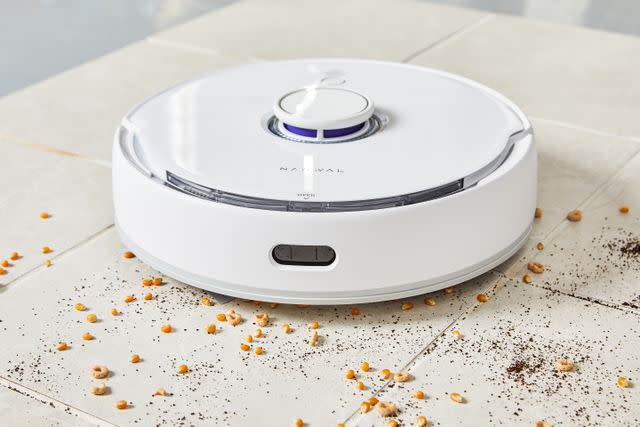
Real Simple / Dera Burreson
How to Shop for a Robot Mop Like a Pro
Mopping Features
You may want to look for a robot mop that has both dry and wet mopping functionality, so you have options of doing a dry sweep or a more thorough clean. Other features to look out for are the size of the water reservoir, whether you can use cleaner or just water in the reservoir, water level adjustability, and mop pad reusability. For homes that have both hardwoods and carpet, you will definitely want a feature that detects carpet, so your robot will know not to mop those areas.
Vacuuming Features
Regardless of whether you have a robot, stick, or upright vacuum, you want your vacuum to have good suction and filters to grab both small and slightly larger particles. Some robot vacuums with carpet sensors can automatically adjust their suction depending on what surface they’re on. Be sure to choose a robot that works on the surfaces you have in your home, whether that’s mostly carpet or mostly hard floors.
Self-Emptying
If you plan on using a robot vacuum and mop frequently, a self-emptying feature will be important. Since dustbins on robot vacuums are much smaller than the average vacuum cleaner, you need to empty it much more—potentially even in the middle of a cleaning if you are doing your entire home. With a self-emptying feature, the robot will deposit their contents into the dock, saving you multiple trips to the garbage can. Some robot mops, like the Bissell ReadyClean A3 Robotic Mop, even automatically switch out the cleaning pads when they get too dirty.
Object-Avoidance
The ability to avoid objects on your floor is important in a robot mop, especially if you plan on scheduling cleanings when you’re not in the same room or even at home. You don’t want to worry about a vacuum sucking up a random toy or sock left on the floor, or constantly crashing into your furniture, or even you or a furry family member. Many robot vacuums and mops have sensors to detect objects and then navigate around them, or you can create boundaries using the cleaning maps in the robot’s app. Take note, though, that while most robot mops can avoid smaller obstacles, many of them aren’t quite smart enough to avoid hitting walls or larger objects. With that said, once they hit a big object, they readjust—you just might hear some wall-hitting noises.
Wi-Fi/Smart Home Connectivity
One of the benefits of a robot mop is that it makes cleaning easier to schedule regularly, and that is usually done by connecting through an app via Wi-Fi. Using an app allows you to adjust the map of your home, customize cleaning areas, schedule cleaning, see cleaning status, and manage the mop itself, all remotely from your phone. Smart home connectivity allows you to connect your robot vacuum to other smart devices in your home, or leverage voice assistants like Alexa or Google to control the device. While most robot mops come with an app, not all of them come with smart home connectivity.
Smart Mapping
Because every home is different, a robot map with smart mapping can help you clean yours effectively and without much supervision from you. “Smart mapping enables robot mops to navigate efficiently, avoiding obstacles and covering entire areas without wasting time,” says Toner. You can also create virtual boundaries or no-go zones to make sure the robot mop doesn’t go where you don’t want it to.
However, because smart mapping is more sophisticated technology, robot maps that have this capability tend to be more expensive. In addition, “smart mapping relies on sensors, so malfunctions or sensor limitations can affect navigation accuracy,” says Toner.
Pad Types
Robot mops can come with different types of pads, including disposable and reusable options. Disposable pads are more environmentally friendly but you need to wash them after each use, which can be a chore in and of itself (though some are machine-washable on a gentle cycle). Disposable pads are more convenient, especially if you are mopping often, but they are less eco-friendly, and you have to remember to continually restock them.
“If you are getting one with pads, get disposable ones because the reusable ones wear out quickly and don’t clean as well once they get dirty,” says Chris Willatt, the owner of Alpine Maids.
More Robot Mops to Consider
Ecovacs Deebot T10 Omni: We were incredibly impressed with this robot’s performance. It self-empties with no trouble, avoids obstacles and navigates with ease, has a deep cleaning feature for extra power, and cleans effectively. But, for the higher price we wish the app was more intuitive to use and the water tanks were easier to fill.
Shark Matrix Plus 2-in-1 Robot Vacuum and Mop: Unlike with most robot mops, we were actually more impressed with the mopping feature of this Shark model than we were with its vacuuming abilities. Still, the self-emptying feature is only for the vacuum, so it requires extra work if you use it to mop frequently.
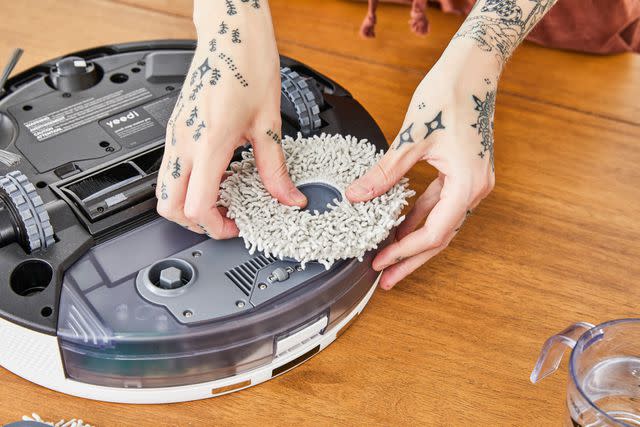
Real Simple / Dera Burreson
Questions You Might Ask
Can a robot mop fully replace a regular mop?
Even with all their bells and whistles, a robot mop will not likely be able to replace a traditional mop for deep cleaning. “A traditional mop is going to pick up and attract the dirt and grime on your floor better than a robot will,” says Willatt. “A robot also can't determine if a stain requires you to really put some elbow grease into it, or reach some of the hard-to-reach corners of your home.”
Adds Toby Schulz, co-founder of Maid2Match: “Robot mops are more tuned towards everyday maintenance. For deep cleaning, you’ll still need the traditional version on hand.”
What are the pros and cons of robot mops?
Pros: The biggest pro for a robot mop is that you don’t have to personally clean your floors. “They are a super easy and no-fuss way to clean,” says Willatt. They are also efficient: “Robot mops can work continuously without getting tired or taking breaks. This leads to more efficient cleaning as they can cover large areas in a relatively short amount of time,” says Toner. And since many are app-controlled and have scheduling functions, you don’t even need to be home to have your floors cleaned.
Cons: Setting up robot mops takes a bit of trial and error, says Willatt. “You don’t know where in your home your robot mop is going to get stuck.” As they cost much more than a regular mop (and regular robot vacuum), they can also be a significant investment for a household. Robot mops also require maintenance. “Regular cleaning of the robot itself, replacing brushes and pads, and addressing any technical issues can be time-consuming,” says Toner. Even the smartest robot can’t outsmart human judgment. “They may not be able to handle unexpected situations. While many robot mops have obstacle detection features, they might still struggle with complex or cluttered environments, potentially getting stuck, or missing spots,” says Toner.
Can you use a robot mop if you have rugs in your home?
If you have area rugs in your home, that doesn’t preclude you from using a robot map. “While robot mops are designed primarily for hard floors, many models can navigate and clean areas with rugs,” says Toner. “This ultimately depends on the model you’re looking to buy. Some models might struggle to navigate over thicker rugs or high-pile carpets, while others are designed to handle rugs effectively. Robots with advanced sensors and mapping capabilities might be better at transitioning from hard floors to rugs and back,” she adds. In our testing, we found that the Yeedi Mop Station Pro was the most impressive at avoiding rugs while mopping.
Can robot mops damage hardwood?
Most robot mops have multiple settings for floor surfaces, or options to select different water levels. To ensure you don’t damage hardwood floors, check to make sure the option you’re looking at has a hardwood setting, “which will minimize the moisture it applies while cleaning,” says Schulz.
Can you put vinegar or floor cleaner in a robot mop?
While vinegar is generally an effective cleaning ingredient, you may want to keep it away from your robot mop. “It's generally not recommended to put vinegar or floor cleaners directly into robot mops unless the manufacturer explicitly states that their product is compatible with such substances,” says Toner. “Harsh or acidic substances like vinegar or some floor cleaners might degrade seals, hoses, or other parts of the robot over time. Improper cleaning solutions can also lead to residue buildup, clogging, or even damaging the robot's cleaning mechanisms.”
How much should you expect to pay for a robot mop?
Robot mops can cost several hundred dollars, with some over $1,000, depending on the features included. Our best budget pick, the Yeedi Vac Station, costs $500, while our most expensive pick, the Narwal Freo, retails for nearly $1,600.
Like a robot vacuum, a robot mop is a significant investment, but ultimately having a programmable cleaning device should help save you time (which is money, too). If you want to save, consider buying a device that is just a robot mop and not a vacuum-mop combo, like the Bissell ReadyClean A3 Robotic Mop.
Take Our Word for It
This article was written by Lesley Chen, a contributing writer for Real Simple who covers commerce, home, and lifestyle stories. To find the best robot mops, we tested 16 popular models, some over a span of six months, evaluating each on setup, effectiveness, noise level, features, maneuverability, and ease of emptying. For expert advice, Lesley spoke to Toby Schulz, co-founder of Maid2Match, Chris Willatt, the owner of Alpine Maids, and Karina Toner, Operations Manager at Spekless Cleaning.
What Is Real Simple Selects?
Next to each product on this list, you may have noticed a Real Simple Selects seal of approval. Any product appearing alongside that seal has been vetted by our team—put through tests and graded on its performance to earn a spot on our list. Although we buy most of the products we test, sometimes we do get samples from companies if purchasing a product ourselves isn’t an option. All products go through the same rigorous process, whether they are purchased or sent by the company.
Love our recommendations? Check out more products that have earned the Real Simple Selects, from humidifiers to cordless vacuums.
For more Real Simple news, make sure to sign up for our newsletter!
Read the original article on Real Simple.

 Yahoo Movies
Yahoo Movies 
